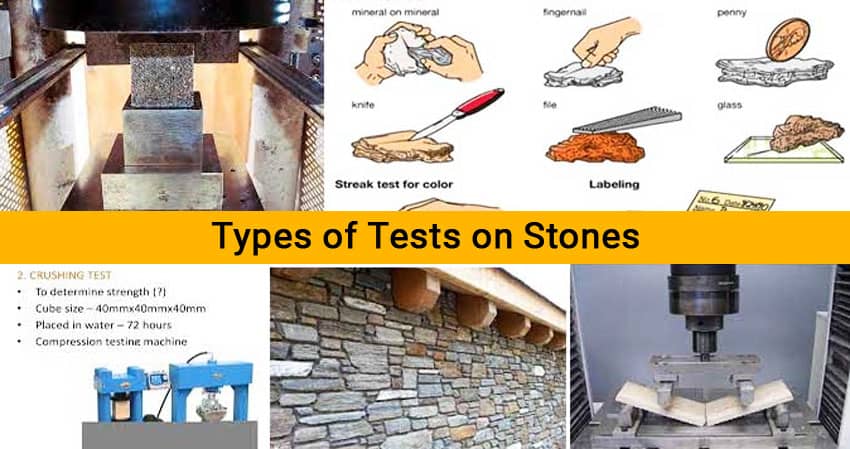Quality Tests on Stones and its types

Stones are derived from rocks. Stones are natural resources used in people's day-to-day lives for various purposes. Stones have no particular shape or composition. In the field of construction in a building, a stone is tested before its implementation.
Tests on Stone Building
- Crushing test
- Impact test
- Acid test
- Water absorption test
- Abrasion test
Crushing Test on Building Stone
To determine the crushing strength of a stone, a compression machine is needed. A specimen of the size 40 x 40 x 40 is taken from the main bigger stone. Later, the sides are dressed finely and set down in the water for three days. This specimen is provided with a layer of plaster of paris from the top to bottom to get the even surfaces of the rocks so the load can be allocated uniformly.
Impact test on Building stone
The impact test of a stone is a universal test for investigating the durability of the stone to be used in construction. To conduct the test, a Cylinder of diameter 25mm and height of 25mm is cut out from the stone sample. Then it is placed on the machine. Aggregates of size 10mm to 12.5mm are finned within the cylinder in three equal layers, and the layers have been tampered with 25 times.
Similar proportions are then transferred to the cup and then again fiddled 25 times. There is a hammer in the machine, which is then permitted to fall freely on the specimen 15 times. Then the specimen is sieved through a 2.36mm sieve and then calculated by a formula.
Then, Impact value = W2/W1 where W2 = Weight of Fines and W1 = Original Weight.
Acid test on Building stone
The acid test is generally carried out on sandstones to scrutinize the presence of calcium carbonate, which erodes the weather resisting quality.
A sample of stone weighing about 50 to 100 gm is taken and retained in a one percent hydraulic acid solution for a week. The solution is ruffled at intervals. If the building stone is good, it will maintain its sharp edges and keep its surface intact.
If the edges are broken and powder is formed on the surface, it means calcium carbonate is present. Such stones will have lower weather resistance.
Water absorption test on stone
This test is carried out to check the amount of pore and space present in the rock. It gives an idea of the strength of the rock, A few pieces of cubes of stone are taken, each of the weight of 50GM.
The stone is then dried in an oven at a stable 150-degree-Celcius for a period of 72 hours. The sample is then weighed and put into water for 72 hours to ensure maximum absorbance.
Each of the samples is then taken out of the water, and the water is then dried off with a cloth; then, the wetness is calculated with the formula.
Absorption = (s-w)*100/w
Abrasion Test of Stone
This test is performed to show durability against the grinding action under traffic. This test is performed on stones because they are used as aggregates for road construction. Any of the following methods could conduct the test to determine the suitability of aggregates.
- Deval Abrasion Test
- Los Angeles Abrasion Test
- Dorry's Abrasion Test
Among these methods, the Los Angeles abrasion test is preferred as the test results have a good correlation with the performance of the pavements.
Conclusion
The tests performed on stones are performed to determine the stones' strength, usefulness, and durability. The proper tests will help choose the best material for constructing a building.
To learn more, watch the following video tutorial.
